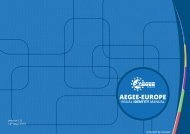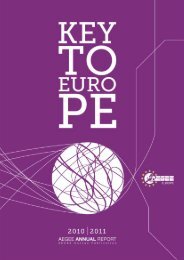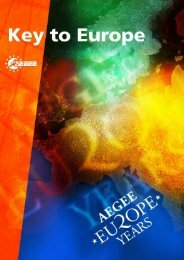turkish-greek civic dialogue - AEGEE Europe
turkish-greek civic dialogue - AEGEE Europe
turkish-greek civic dialogue - AEGEE Europe
Create successful ePaper yourself
Turn your PDF publications into a flip-book with our unique Google optimized e-Paper software.
The specific area was chosen quite accidentally. At that time it was a swampy<br />
uninhabited area where nothing indicated it could host people, life and human<br />
activity.<br />
The end of August 1922, the Greek flags were lowered in Asia Minor. Following<br />
the tragic fall of 1922, the Lausanne Treaty was signed, which arbitrates not<br />
only international issues but also Greek-Turkish issues, like the borders of the<br />
two countries, the minorities, and the exchange of population. And it is this<br />
exchange of population that forced over 1,5 million Greeks to abandon their<br />
homes, their fortunes, the land where they, their fathers and forefathers lived<br />
for more than 2,500 years and uprooted take the road to refuge.<br />
A large group of people – members of 90 families from the Ionian small towns of<br />
Makri and Livisi – one cloudy cold morning of November of 1923 arrived here, on<br />
the rocks of Xylokerisa in Attica, all beaten by adverse fate and the pain of life,<br />
however armed with courage and steel determination for a better tomorrow.<br />
They were not allowed to bring anything with them; only a few clothes and the<br />
will to live. On this very land we set out foot on, live and enjoy today, there<br />
was nothing but woods and a barren land with pine trees and small bushes.<br />
Right next were the swamps full of water snakes, mosquitoes and leeches. The<br />
only inhabitants were 10 shepherds’ families.<br />
Building of the houses started in the spring of 1924 and continued until 1927. The<br />
houses were distributed by drawing lots. As soon as one house was completed<br />
the family entitled to it moved in. Water was brought from the monastery of<br />
Agia Paraskevi and the first fountain was built under the great pine tree of<br />
the central square. Life started to flow. Malaria was decimating older people<br />
and children and there were no doctors or medicines until 1934, when the<br />
draining works were carried out in the area by the Rockefeller Foundation. The<br />
newcomers drew wells, started cultivating and selling their corps up to the<br />
areas of the Messogaia plain and Kifissia. And they flourished.<br />
In our present day, Nea Makri, the area the refugees landed on in 1922, is<br />
converted step by step into a real paradise. The habitation, economic and<br />
touristic development of Nea Makri in the last years has been rapid. It stretches<br />
in 33,662 acres and the permanent habitants are 13,000. As a touristic resort<br />
in the summer it reaches 55,000 – 60,000 inhabitants since many people own<br />
summer houses in the area.<br />
Association des Etats Généraux des Etudiants de L’<strong>Europe</strong><br />
LOCAL COMMUNITY IMPACT<br />
The Turkish Greek Civic Dialogue Project events all had unique impact on<br />
the local community where the events took place. All the activities were<br />
organised in collaboration and participation with city councils, municipalities,<br />
universities, colleges and local NGOs from Sakarya to İstanbul. However, the<br />
local community impact of the KayaFest, the way it influenced and changed<br />
the life of a village and its villagers is particularly striking.<br />
The involvement of villagers into the project had started at the very beginning<br />
of the planning phase. The Turkish-Greek Civic Dialogue Project Coordination<br />
Team gathered members from <strong>AEGEE</strong>-Ankara and prepared three case study<br />
trips to Kayaköy with the aim to learn expectations of villagers and other<br />
relevant stakeholders, to get to know about the village and its story, to share<br />
the ideas we had, to see their reactions, to conduct feasibilility and make<br />
measurements on the land. We also had numerous never ending meetings with<br />
the “muhtar” village head Erkan Kaya, KayaKöy Cooperative, Fethiye Chamber<br />
of Architects, Fethiye Promotion Foundation- FETAV, Fethiye local newspapers,<br />
Fethiye Municipalitiy, Muğla Governorship, Fethiye Museum, TÜRSAB, villagers,<br />
pension and restaurant owners at the village as well as primary schools,<br />
gendarmeries, fire brigade, Turkish Telecom, travel agencies, boat operators.<br />
Finally, the villagers and all local stakholders contributed very well to the<br />
content, logistics and the programme of the festival.<br />
At the beginning both the infrastructure of the village and the mind-set of<br />
villagers and architects didn’t really portray a positive situation as to organise<br />
a peace festival in the Kaya village. The village did not have decent asphalted<br />
roads, especially the basin where we wanted to locate our main stage was very<br />
dusty as a deserted land. There were simply no lights for the illimunation of<br />
the cultural heritage on old rock houses and churches, no public phone booths,<br />
not enough toilets for public use. Apart from that, there was no statistical data<br />
about the village, no one knew exactly how many households were living in<br />
the village, how many of them could host how many people. There was not<br />
any map of the village. We were quite thankful to receive the drawings of<br />
the British couple who are living in the village. A second challenge was the<br />
KayaFest Youth and Culture Festival<br />
113







